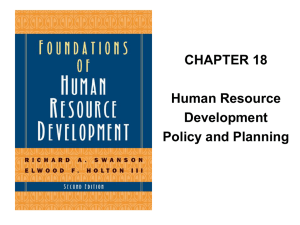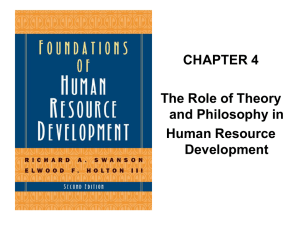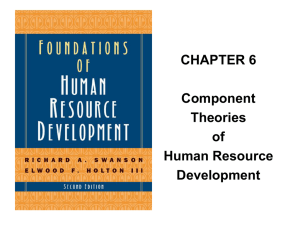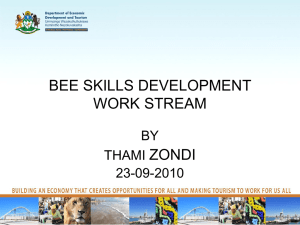“HRD Climate in Selected Public Sector Banks : An Empirical Study”
advertisement
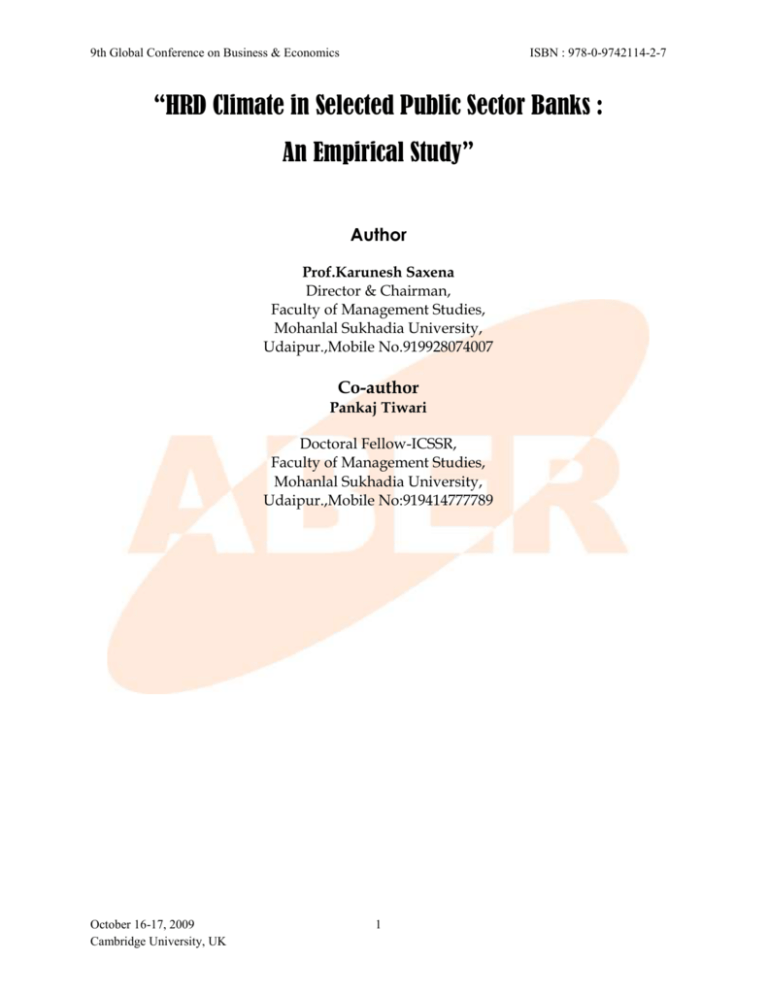
9th Global Conference on Business & Economics ISBN : 978-0-9742114-2-7 “HRD Climate in Selected Public Sector Banks : An Empirical Study” Author Prof.Karunesh Saxena Director & Chairman, Faculty of Management Studies, Mohanlal Sukhadia University, Udaipur.,Mobile No.919928074007 Co-author Pankaj Tiwari Doctoral Fellow-ICSSR, Faculty of Management Studies, Mohanlal Sukhadia University, Udaipur.,Mobile No:919414777789 October 16-17, 2009 Cambridge University, UK 1 9th Global Conference on Business & Economics ISBN : 978-0-9742114-2-7 Abstract The business organizations are attaching great importance to human resource because human resources are the biggest source of competitive advantage and has the capability of converting all the other resources in to product/service. The effective performance of this human resource depends on the type of HRD climate that prevails in the organization, if it is good than the employee’s performance will be high but if it is average or poor then the performance will be low. The study of HRD climate is very important for all the organization and the banking sector is not an exception, especially in the present situation of financial recession. The present study is an attempt to find out the type of HRD climate that is prevailing in public sector banks in Ahmedabad. The researcher have also tried to find out the difference in the perception of employees regarding HRD climate on the basis of age, gender, designation, qualification. The researcher collected the data from the employees of selected public sector banks using structured HRD climate questionnaire .The data were analyzed using several statistical tools such as mean, standard deviation, percentiles, Z test. The result shown that the HRD climate in public sector banks is average and the perception of employees regarding the HRD climate do not differs significantly on the basis of gender, qualification and designation but it differs significantly on the basis of age . The paper ends by offering useful suggestions to the management involved in the operations of the banks. Key words: HRD climate, Public sector Banks, Performance October 16-17, 2009 Cambridge University, UK 2 9th Global Conference on Business & Economics ISBN : 978-0-9742114-2-7 INTRODUCTION HRD CLIMATE Human resource development (HRD) is concerned with the provision of learning and development opportunities that support the achievement of business strategies and improvement of organizational, team and individual performance (Armstrong and Baron, 2002). Climate, this is an overall feeling that is conveyed by the physical layout, the way employees interact and the way members of the organization conduct themselves with outsiders. (It is provided by an organization.) HRD Climate is an integral part of organizational climate. It is the perception the employee can have on the development environment of an organization. The developmental climate will have the following characteristics (Rao & Abraham, 1986): 1. A tendency at all levels starting from the top management to the lowest level to treat the people as the most important resources. 2. A perception that developing the competencies in the employees is the job of every manager. 3. Faith in capability of employees to change and acquire new competencies at any stage of life. 4. A tendency to be open in communication and discussion rather than being secretive 5. Encouraging risk taking and experimentation 6. Making efforts to help employees recognize their strengths and weaknesses through feedback October 16-17, 2009 Cambridge University, UK 3 9th Global Conference on Business & Economics ISBN : 978-0-9742114-2-7 7. A general climate of trust 8. Team spirit 9. Tendency to discourage stereotypes and favoritism 10. Supportive personnel policies 11. Supportive HRD practices include performance appraisal, reward management, potential development, job rotation and career planning. . REVIEW OF LITERATURE Many researches have been conducted on HRD climate .The result has shown that HRD climate affects the performance of the employees. Some of the important studies are as follows: Banu (2007) conducted study in public sector Cement Corporation in Tamil Nadu and found that sound HRD Climate is necessary for the success of the public sector undertakings. Srimannarayana M, (2007) conducted a study in local bank of Dubai and found that a good HRD climate was prevalent in the organization. He found out the differences in the perception of employees regarding the HRD climate on the basis of demographic variables. Mufeed & Gurkoo, (2006) attempted to study whole gamut of HRD climate in universities and other equivalent higher level academic institutions by eliciting employee perceptions on HRD climate for which the University of Kashmir, Srinagar is selected as the main focal point of study. October 16-17, 2009 Cambridge University, UK 4 9th Global Conference on Business & Economics ISBN : 978-0-9742114-2-7 Mufeed SA, (2006) examined the HRD climate in major hospitals.The result indicated the existence of poor HRD climate in the hospitals. Sampath & Kalpana, ( 2005) conducted a study and found that to a large extent organizations where knowledge workers work, enjoy a ‘good’ HRD Climate. The strengths of the HRD Climate emerges from the organization’s belief that the human factor is a critical factor and need commitment to development, team spirit, helpfulness and providing training on skills and knowledge. The result indicated the presence of psychological climate conducive for development. Venkateswaran, (2002) made a study in a public sector undertaking in India and found that, to a large extent, a favorable HRD Climate was prevalent in the organization. Bhardwaj & Mishra, (2002) examined the HRD climate in private sector organization. The result shown the existence of good HRD climate in the organization. The managers were satisfied with the HRD policies and practices of the organization. Alphonsa, (2000) conducted a survey to examine the HRD climate of private hospital. The responses were collected from different departments in the hospital. The researcher found that the perception of the supervisors about the HRD climate is satisfactory and reasonably good climate was prevailing in the hospital. October 16-17, 2009 Cambridge University, UK 5 9th Global Conference on Business & Economics ISBN : 978-0-9742114-2-7 Sharma and Purang (2000) conducted a study to find out the relationship between value institutionalization and HRD climate in engineering and manufacturing sector and found the positive relationship between the two variables. Krishna and Rao, (1997) carried out a comprehensive empirical study in. BHEL, Hyderabad and found that HRD climate in the organization encouraged middle and senior managers Rao and Abraham, (1986) found that the general HRD climate in the organization appears to be at an general level. OBJECTIVES OF THE STUDY The study intends to achieve the following objectives: 1. To study the type of HRD climate prevailing in some selected public sector banks in Ahmedabad. 2. To study the differences in the perception of employees on the basis of gender. 3. To study the differences in the perception of employees on the basis of age. 4. To study the differences in the perception of employees on the basis of designation. 5. To study the differences in the perception of employees on the basis of qualification. RESEARCH DESIGN SAMPLING For the purpose of the study, the researcher selected the banks on the basis of judgmental sampling and respondents on the basis of non probability random sampling. October 16-17, 2009 Cambridge University, UK 6 9th Global Conference on Business & Economics ISBN : 978-0-9742114-2-7 SAMPLE DESIGN Data Collection and period of study The researcher personally contacted 150 employees in three banks in Ahmedabad during January and February 2009.They were appraised about the purpose of the study and request was made to them to fill up the questionnaire with correct and unbiased information. The researcher was able to collect the 98 filled questionnaires with response rate of 65.33 %. Finally 90 filled in questionnaire were selected for this study after rejecting 17 questionnaires for various reasons like errors, incompleteness and inadequate information. SAMPLE PROFILE Tab.1.1 Gender wise distribution of Employees Tab.1.2 Age wise distribution of Employees Tab. 1.3 Designation wise distribution of Employees Tab. 1.4 Qualification wise distribution of Employees QUESTIONNAIRE HRD Climate questionnaire developed by the centre for HRD at XLRI , was used by the researcher to collect the responses from the respondents. The scale consist of 38 items each having five alternatives such strongly agree, agree, undecided, disagree, strongly disagree. The mean score of each item could theoretically range from 1.0 to 5.0 where 1.0 indicates extremely poor HRD climate and 5.0 indicates extraordinarily good HRD climate on that dimension. These scores are never almost never obtained by any organization. Scores around October 16-17, 2009 Cambridge University, UK 7 9th Global Conference on Business & Economics ISBN : 978-0-9742114-2-7 3.0 indicate an ‘average’ HRD climate on that dimension giving substantial scope for improvement. Scores around 2.0 indicate poor HRD climate on that dimension .Scores around 4.0 indicates a good HRD climate where most employees have positive attitudes to the HRD policies and practices on that dimension and thereby to the organization itself. DATA ANALYSIS AND FINDINGS Tab.2.1. Mean and % Scores of All the three Banks Table 1 provides an idea about the HRD Climate prevailing in the selected public sector banks of Ahmedabad. The mean and % score indicate that the HRD Climate in selected public sector banks is average and there is a tremendous scope of improvement in the HRD climate. TESTING OF HYPOTHESIS Hypothesis 1 H0: The difference is not significant between the perception of male and female employees. Ha: The difference is significant between the perception of male and female employees. Tab.2.2 Perceptual differences between male and female employees The calculated Z value (- 0.40) falls under the acceptance region (-1.96 to +1.96) at 0.05 significance level, therefore we accept the null hypothesis that the difference is not significant between the perception of Male and Female employees regarding the HRD Climate in Public banks. Hypothesis 2 October 16-17, 2009 Cambridge University, UK 8 9th Global Conference on Business & Economics ISBN : 978-0-9742114-2-7 H0: The difference is not significant between the perception of Elder and Younger employees. Ha: The difference is significant between the perception of Elder and Younger employees. Tab.2.5. Perceptual differences between Elder and Younger Employees The calculated Z value (- 2.28) falls outside the acceptance region (-1.96 to +1.96) at 0.05 significance level, therefore we reject the null hypothesis and conclude that the difference is significant between the perception of Elder and Younger employees regarding the HRD climate. If we look at the means of the Elder and younger employees, it is clear that the younger employees have favorable attitude towards HRD climate as compared to elder employees. It might be because of the fact that in the present financial crisis, the younger employees have fear in their mind of losing the job and they feel satisfied with whatever they have but if we talk about the senior employees, they are well settled in their job and they feel dissatisfied with the HR policies and practices of the organization over the passage of time. Hypothesis 3 H0: The difference is not significant between the perception of Executive and Non Executive employees. Ha: The difference is significant between the perception of Executive and Non Executive employees. Tab.2.3 Perceptual differences between Executive and Non Executive Employees The calculated Z value (- 0.71) falls under the acceptance region (-1.96 to +1.96) at 0.05 significance level ,therefore we accept the null hypothesis that the difference is not significant October 16-17, 2009 Cambridge University, UK 9 9th Global Conference on Business & Economics ISBN : 978-0-9742114-2-7 between the perception of Executive and Non Executive employees regarding the HRD Climate in Public banks. Hypothesis 4 H0: The difference is not significant between the perception of graduate and post graduate employees. Ha: The difference is significant between the perception of graduate and post graduate employees. Tab.2.3.Perceptual differences between Graduate and Post Graduate Employees The calculated Z value (- 0.45) falls under the acceptance region (-1.96 to +1.96) at 0.05 significance level ,therefore we accept the null hypothesis that the difference is not significant between the perception of Graduates and Post Graduates employees regarding the HRD Climate in Public banks. RECOMMENDATIONS To improve the HRD climate in the public sector banks the following steps should be taken immediately. 1. Necessary changes should be introduced in HR policies and practices. 2. The management should take necessary action to bridge the communication gap with employees and try to develop the trust among the employees. Clear communication process will help to establish the HRD Climate. October 16-17, 2009 Cambridge University, UK 10 9th Global Conference on Business & Economics ISBN : 978-0-9742114-2-7 3. The employees should be encouraged to express their feelings without any fear. 4. Feedback should be taken at fixed intervals to know the drawbacks in the system. 5. HR policies of the organization should be such that which encourages the employees to contribute their best. 6. Proper authority should be given to employees so that they can take the decision at the right time. 7. Management should discourage the stereotypes and favoritism. They should treat with all employees on equitable basis. 8. Team Spirit should be encouraged among the employees. LIMITATIONS OF THE STUDY 1. The study was conducted in Ahmadabad in selected public sector banks, which may not give the exact picture of the situation. 2. The study was completed within limited time period. 3. The sample size was very small. CONCLUSION HRD climate plays a very important role in the success of any organization because directly or indirectly it affects the performance of the employees. If the HRD climate is good than the employees will contribute their maximum for the achievement of the organizational objectives. The result of the present study shown that the HRD climate in the public sector bank is average and there is lot of scope for improvement in the HRD climate. The result also shown that there is no difference in the perception of the employees on the basis of gender, qualification, October 16-17, 2009 Cambridge University, UK 11 9th Global Conference on Business & Economics ISBN : 978-0-9742114-2-7 designation but the perception of the employees differs on the basis of age. The management can improve the HRD climate by introducing the changes HR policies and practices. BIBLIOGRAPHY 1. Jeykumaran et al (2009), “Man Job fit Factors and Occupational Stress among the Managers of Cement Industries in Tamil Nadu”, ACRM Journal of Business and Management Research, Vol.4, No.:1, pp 20-25. 2. Rao Subba P,(2007), Personnel and Human Resource Management, Himalaya Publishing House Pvt. Ltd., Mumbai . 3. Bhadu Shishupal Singh & Dhodi M L, (2007), “Performance Appraisal Practices in Select Manufacturing and Mining Industries of Southern Rajasthan”, Amity Journal of Business, Vol. No.pp. 4. Srimannarayana M (2007), “Human Resource Development Climate in a Dubai Bank” , Icfai Journal of Organizational Behavior, Vol. 6, No. 1, pp. 33-40. 5. Mufeed, S.A., (2006), Enhancing Educational Institutions Effectiveness through HRD climate: An Empirical Study, Management and Change, Vol. 10, No.2, pp 25-64. 6. Hyde M Anukool & Pethe Sanjyot (2005), “Impact of HRD Climate on Empowerment and organisationla Ciizenship Behavior”, Icfai Journal of Organisational Behavior,Vol.IV, No.3,pp 45-50. 7. Priyadarshini R Rani Geetha & Vankatpathy R, (2005), “Performance and HRD: A Study Among Various Types of Banks”, South Asian Journal of Management , Vol.12, No.3,pp 52-66. October 16-17, 2009 Cambridge University, UK 12 9th Global Conference on Business & Economics ISBN : 978-0-9742114-2-7 8. Rodrigues Lewlyn L R, (2004), “Correlates of Human Resource Development Climate Dimensions: An Empirical Study in Engineering Institutes in India”, South Asian Journal of Management”, Vol.11, No.2, pp 81-91. 9. Cooper Donald R., Schindler Pamela S, (2003), Business Research Methods, Tata McGraw Hill, New Delhi. 10. Armstrong, M. and Baron A, (2002), Strategic HRM: The Key to Improved Business Performance, CIPD, London. 11. Bhardwaj; Gopa and Mishra, Padmakali., (2002), “HRD Climate: an empirical Study Among Private Sector Managers”, IJIR, July Vol. 38(1). 12. Alphonsa, V.K, Sr., (2000), HRD Climate in a Private Hospital in Hyderabad-An Empirical Study, IJTD, Vol. XXX (4) . 13. Sharma, A and Purang, P., (2000), “Value Institutionalization and HRD Climate: A Case Study of a Navratna Public Sector Organisation”, Vision-The Journal of Business Perspective, Vol. 4 , pp 11-17. 14. Rao T. V. ,(1999), Evaluating the Human Resource Function for Business Improvement, Response Books Pvt. Ltd., New Delhi. 15. Mufeed SA & Rafai SN, “Need for Octapace Culture in Tourism Sector: An Instrument for Organizational Dynamics” (http://www.iceg.net/2007/books/3/10_345_3.pdf) (Assesed on 18/04/2009) 16. http://www.arpitha.com/downloads/009STUDY_OF_BELONGINGNESS_AMONG_KNOWLEDGE_WORKERS.pdf (Assessed on 15/04/2009) October 16-17, 2009 Cambridge University, UK 13 9th Global Conference on Business & Economics ISBN : 978-0-9742114-2-7 17. www.indianjournals.com/ijor.aspx?target=ijor:mc&volume=10&issue=2&article=002 &type=fulltext. (Assessed on 17/04/2009) Employees Gender N Percent Male 54 60.00 Female 36 40.00 Total 90 100 Tab.1.1 Gender wise distribution of Employees Age (Years) Employees N Percent Above 35 52 57.78 Below 35 38 42.22 Total 90 100 Tab.1.2 Age wise distribution of Employees Employees October 16-17, 2009 Cambridge University, UK N Percent Executive 51 56.67 Non Executive 39 43.33 Total 90 100 14 9th Global Conference on Business & Economics ISBN : 978-0-9742114-2-7 Tab. 1.3 Designation wise distribution of Employees Educational Employees Qualification N Percent Graduate 50 55.56 Post Graduate 40 44.44 Total 90 100 Tab. 1.4 Qualification wise distribution of Employees Bank Mean Scores Percentage Scores All the three banks 3.08 52.22 % Tab.2.1. Mean and % Scores of All the three Banks Particulars Sample Size Mean Variance SD SE Z-Value Male Employee 54 125.28 165.89 12.88 2.54 -0.40 Female Employees 36 126.22 84.09 9.17 LS 0.05 Tab.2.2. Perceptual differences between male and female employees October 16-17, 2009 Cambridge University, UK 15 9th Global Conference on Business & Economics Particulars ISBN : 978-0-9742114-2-7 Sample size Mean Variance SD SE Z value Graduate Emp. 50 125.16 111.19 10.54 2.49 -0.45 Postgraduate Emp. 40 126.3 159.90 12.64 LS 0.05 Tab.2.3.Perceptual differences between Employees with graduate and postgraduate qualification Particulars Sample size Mean Variance SD SE Z value LS Executives 51 124.86 77.08 8.78 2.60 -0.71 0.05 Non Executives 39 126.71 205.26 14.33 Tab.2.4. Perceptual differences between Executive and Non Executive Particulars Sample size Mean Variance 52 122.90 38 128.52 Elder Younger SD SE Z value LS 83.89 9.15 2.46 -2.28 0.05 85.66 13.62 Tab.2.5. Perceptual differences between Elder & Younger employees. October 16-17, 2009 Cambridge University, UK 16
